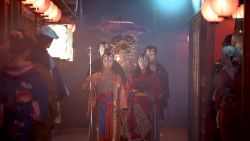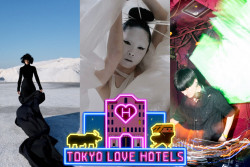
May 22, 2008
Shooting Asia
In Looking East, iconic photographer Steve McCurry portrays the continent and its people
By Metropolis
Originally published on metropolis.co.jp on May 2008

All images copyright ©2008 Steve McCurry. Used with permission.
Some well-known photographers struggle to capture the surly sneer or insincere smile of an over-made-up supermodel. Steve McCurry, by contrast, has made a career out of getting personal with an entire continent. Looking East, a near life-sized collection of portraits from the leading photographer of Asia and its people, includes McCurry’s most renowned photo: the iconic image of Afghan refugee Sharbat Gula that, after appearing on the cover of National Geographic in 1984, became not only a symbol of the defiance of the Afghan people to the Soviet invasion, but also of humanity’s endurance.
Interviewed shortly after a recent photo shoot in Thailand, the legendary lensman was forthcoming regarding his impressions of Asia, his approach to photography and, especially, the iconic shot of Gula, a young Pashtun orphan, whom he snapped on a visit to a refugee camp in Pakistan. So, what did this photo have that set it above all the other compelling images he has taken over his career?
“I think it’s a combination of several things,” the 58-year-old Philadelphia native says. “First of all, she’s a very beautiful little girl. I think there’s an ambiguity, a mystery about her expression. I think there’s a kind of haunted, troubled quality on one level, but also fortitude, perseverance, respect, and pride to her look. It’s clear that she’s poor—she has this torn shawl. But with her poverty, she has this dignity.”
Ambiguity, in this case the girl’s expression, has always played a vital part in art, going back to the Mona Lisa’s mysterious smile. But there is another ambiguity at play here, one of whether the girl is different from us or similar to us. To most Westerners, Afghanistan is the end of the Earth, a dangerous, mysterious place where we assume that the people are completely alien. Yet McCurry’s picture shows a girl who, with a change of clothes, could effortlessly blend into Western society. Surely, this is also part of this image’s appeal for Westerners?
“Well, that’s a good point,” he responds. “Afghanistan, being the crossroads of culture, there’s a segment of the population that came down with Genghis Khan, the Hazaras. Then you have a very strong Indian influence. Then some of these people, you would swear they were Western European. If they were walking down the street in Munich, Paris or Milan, they would look like the local people. There’s an interesting mix of cultures in Afghanistan and I think her face and her look illustrates that. It’s not an identifiable look. It’s a sort of a mix. She looks kind of Western and she looks kind of Afghan.”

Kumbha Mela Festival, Haridwar, India, 1998
Ultimately, the central appeal of McCurry’s work is that he shows us something different from our one-size-fits-all, global, urban world. In his beautiful photographs of Asia, he presents a continent of incredible diversity. This has always been the region’s main attraction for him.
“There’s such a variety of culture, and there’s such a range between different countries and regions,” he enthuses. “The difference between Pakistan and Afghanistan was so radical, and then from that culture over to Nepal and Tibet. I found such interesting religions, from Islam over to Buddhism, Hinduism, the Sikhs, the Jains, the Parsees, all sorts of things.”
We’d do well to note that this is not the politically correct “diversity” we hear so much about in the West, a superficial, hothouse phenomenon. Instead it is a diversity that exists on the rugged face of Asia and stands on its own two feet; a diversity that has defined itself through centuries of struggle and adaptation to harsh environments and the pressures of neighboring groups. Although McCurry praises the multiculturalism of Western cities, there is a sense that their diversity is not as authentic as it is in Asia.
“There is an amazing mix of culture in New York, but it’s completely different,” he explains. “In New York, people are trying to assimilate, and to some extent conform to the laws and the customs and the traditions. You simply don’t get the same kind of raw, original culture that you get on the streets of Calcutta or Kabul. In a place like Tibet, Buddhism is a very important part of people’s lives. I think of these monks who prostrate themselves from their village to Lhasa, and sometimes it takes months and even years. That’s a very different situation from life in the States or Europe. In India, there are literally millions of people who live on the streets. In New York, there are probably a few thousand. That’s a significant difference.”

Kuwait, 1991
McCurry’s work is all about documenting these fascinating and authentic differences. From a turbaned Sikh schoolboy in Kabul with a rubber-ended pencil sticking out of his blazer pocket (which hints at the residual influence of British colonial influence) to the ancient face of a Tibetan monk whose leathery skin seems to reflect the rugged landscape and dry air of his land, McCurry’s portraits succeed in giving us a sense of the history, geography, climate and culture that shaped his subjects.
Yet even though showing differences is vital to McCurry’s work, the methods he uses stress our common humanity. “The first thing you need to do when you approach people is to see them and relate to them as real people, not somehow ‘quaint’ or ‘foreign’,” he says. “If you can just relate to people as real people and establish some rapport—whether you joke around with them or whatever—people respond and open up, and are happy to be photographed. I don’t think there’s any mystery or trick about it. I think a lot of times the mistake people make, is that they see these people as different. But once you break that ice they’re like anybody else—they just happen to be working in a field or as a monk in a monastery.”
Despite his emphasis on a common humanity, McCurry’s success—and his safety—depend on a careful understanding of the very real differences between the peoples and cultures of the different regions he visits. One of the most significant, he has noticed, is the difference between Buddhism and other religions.
“If there was one religion I admire, it’s Buddhism,” he confides. “With the Buddhists that I’ve encountered, there’s compassion, there’s a respect for all life, and there’s lots of peace and serenity. There’s a non-judgmental quality. If you look at all these statues and images of Buddha around the world, he has this very loving, very compassionate atmosphere. There’s this real sense of wisdom and acceptance. There is this love that exudes that I think people find comforting. Also, in most Buddhist cultures, women have a place of respect and very equal status.”

Mandalay Burma, 1994
McCurry’s positive experience of Buddhism contrasts markedly with his experience of Islam, which he has seen under especially difficult conditions in the Afghan War and the first Gulf War.
“With other religions, there’s a kind of violent energy,” he says. “Often if you don’t conform, or you don’t respect ‘our way of thinking,’ then there’s violent consequences. In Buddhist societies, you don’t find that. If you desecrated a sacred text or a temple, there would be a tempered response.”
McCurry has seen and photographed such desecration—namely, the destruction of the giant Buddhas of Bamiyan committed by Afghanistan’s Taliban government in 2001.
“Buddhism has this whole sense of the impermanence of life,” he says, referring to this act of cultural vandalism that shocked the world. “There is a cycle. Things are born and they pass away. I think Buddhists were more surprised at the destruction of the statues than angry. Part of the problem of Islam is that people get so emotional about religion, and they’re so quick to want to defend it by violent means, because they feel that they’ve been disrespected.”
For someone who has made a career out of photographing the rich colors and varied shapes of Asia, McCurry has done remarkably little work in Japan. None of the portraits in Looking East feature Japanese subjects. Is Japan, perhaps, too westernized to be photogenic?
“I’ve been there many times,” he replies. “The most recent time, I was doing an assignment for National Geographic in Kyoto as part of a worldwide survey of Buddhism. I visited a few Zen monasteries in Kyoto and went to Kamakura. But in Japan, something like Buddhism isn’t really that vital for people’s lives. They may consider themselves Buddhist, but I don’t think it really matters that much to them on a daily basis.”
In addition to Japan losing touch with its traditional culture, another problem for McCurry may simply be the pace of life. Much of his best work comes from simple patience and waiting for the photo to happen—something that is not always easy in a fast-paced megalopolis like Tokyo.
“Well, certainly it’s more fun to wander through the streets of a small village in Tibet, where most people walk and are on the street, than it would be in Tokyo,” he says. “I’m not sure how many people in Japan spend time out on the street as opposed to driving round in their cars or their motorcycles.”
Perhaps the real reason for McCurry’s aversion to Japan, however, is that people here are just too self-conscious in front of a camera. It is his search for genuineness, combined with the exoticism of authentically diverse and unique cultures, that has led the photographer to explore rural byways rather than the busy, modernizing highways of Asia. In so doing, he has succeeded like no one else in capturing the face of this remarkable continent.
“Most of the time people are very happy to meet me,” he says. “They don’t think of me as a photographer. They don’t have any concept of journalism. They just think of me as some strange guy from some other part of the world, with a camera.”







